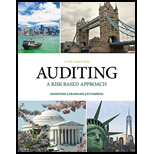
Auditing: A Risk Based-Approach (MindTap Course List)
11th Edition
ISBN: 9781337619455
Author: Karla M Johnstone, Audrey A. Gramling, Larry E. Rittenberg
Publisher: Cengage Learning
expand_more
expand_more
format_list_bulleted
Question
Chapter 9, Problem 23CYBK
To determine
Introduction:
Control risk is the chances of material misstatements in the financial statements arising owing to the absence of, or failure in the functioning of related controls that govern the activities.
To select:
Pick the right option that supports the given condition.
Expert Solution & Answer
Trending nowThis is a popular solution!

Students have asked these similar questions
Can you explain this financial accounting question using accurate calculation methods?
What is the direct labor rate variance?
What is the required sales to achieve this income? Please solve general accounting question do fast
Chapter 9 Solutions
Auditing: A Risk Based-Approach (MindTap Course List)
Ch. 9 - In the revenue cycle, the most significant...Ch. 9 - Which of the following statements is true...Ch. 9 - Prob. 4CYBKCh. 9 - Prob. 7CYBKCh. 9 - Prob. 8CYBKCh. 9 - Prob. 9CYBKCh. 9 - Prob. 10CYBKCh. 9 - Prob. 11CYBKCh. 9 - Prob. 12CYBKCh. 9 - Prob. 13CYBK
Ch. 9 - Prob. 14CYBKCh. 9 - Prob. 15CYBKCh. 9 - Prob. 16CYBKCh. 9 - Prob. 17CYBKCh. 9 - Prob. 18CYBKCh. 9 - Which of the following statements is false...Ch. 9 - Prob. 20CYBKCh. 9 - Prob. 22CYBKCh. 9 - Prob. 23CYBKCh. 9 - Prob. 24CYBKCh. 9 - Prob. 25CYBKCh. 9 - Prob. 26CYBKCh. 9 - Prob. 27CYBKCh. 9 - Prob. 28CYBKCh. 9 - Prob. 29CYBKCh. 9 - Prob. 30CYBKCh. 9 - Prob. 31CYBKCh. 9 - Prob. 32CYBKCh. 9 - Refer to Exhibit 9.1. Which accounts are relevant...Ch. 9 - Prob. 2RQSCCh. 9 - Prob. 3RQSCCh. 9 - An important task ¡n the audit of the revenue...Ch. 9 - Prob. 5RQSCCh. 9 - Prob. 6RQSCCh. 9 - Prob. 7RQSCCh. 9 - Prob. 8RQSCCh. 9 - Prob. 9RQSCCh. 9 - Prob. 10RQSCCh. 9 - Prob. 11RQSCCh. 9 - Prob. 12RQSCCh. 9 - Prob. 13RQSCCh. 9 - Prob. 14RQSCCh. 9 - Prob. 15RQSCCh. 9 - Stainless Steel Specialties (SSS) is a...Ch. 9 - Prob. 17RQSCCh. 9 - Prob. 18RQSCCh. 9 - Prob. 19RQSCCh. 9 - Prob. 20RQSCCh. 9 - Prob. 21RQSCCh. 9 - Prob. 22RQSCCh. 9 - Prob. 23RQSCCh. 9 - Prob. 24RQSCCh. 9 - Prob. 25RQSCCh. 9 - Prob. 26RQSCCh. 9 - Prob. 27RQSCCh. 9 - Prob. 28RQSCCh. 9 - Prob. 29RQSCCh. 9 - Prob. 30RQSCCh. 9 - Prob. 31RQSCCh. 9 - Prob. 32RQSCCh. 9 - Prob. 33RQSCCh. 9 - Prob. 34RQSCCh. 9 - Prob. 35RQSCCh. 9 - Prob. 36RQSCCh. 9 - Prob. 37RQSCCh. 9 - Prob. 38RQSCCh. 9 - Prob. 39RQSCCh. 9 - Read the following scenario about Strang...Ch. 9 - Prob. 41RQSCCh. 9 - Prob. 42RQSCCh. 9 - ZYNGA (LO Z 3, 4, 5, 6, 8) Refer to the Why It...Ch. 9 - UTSTARCOM, INC. (LO 2, 3, 4, 5, 6, 8) UTStarcom is...Ch. 9 - Prob. 47FFCh. 9 - Prob. 48FFCh. 9 - Prob. 55DAUA
Knowledge Booster
Similar questions
- Samantha works as a sales assistant. She receives a weekly wage of $280 plus a commission of $0.12 per dollar of goods sold. During one week, Samantha sold goods worth $2,100. The following deductions apply to her gross earnings: pension contribution of 6.5% of gross earnings and income tax of $55. Calculate Samantha's net earnings for the week.arrow_forwardSolve this financial accounting problemarrow_forwardFennel Industries had 6,420 actual direct labor hours at an actual rate of $15.60 per hour. Original production had been budgeted for 950 units, but only 880 units were actually produced. Labor standards were 7.2 hours per completed unit at a standard rate of $16.10 per hour. What is the direct labor rate variance?arrow_forward
- Please explain the solution to this general accounting problem with accurate principles.arrow_forwardZara Freight Co. has a current stock price of $36. Over the past year, the company reported net income of $4,800,000, total equity of $19,200,000, sales of $33,800,000, and has 3.8 million shares of stock outstanding. What is the price-sales ratio?arrow_forwardI am looking for help with this general accounting question using proper accounting standards.arrow_forward
- In 2022, Rolling Mills, a producer of organic oat flour, had the capacity to produce 12,000,000 pounds of product at a conversion cost per pound of $0.18. The conversion cost per pound was $0.14 in 2021 (the previous year). The direct material cost per pound for both years was $0.09 per pound. In 2022, Rolling Mills produced 10,500,000 pounds, while actual production for the previous year was 9,200,000 pounds. What was the cost of unused capacity in 2022?arrow_forwardCompute the total manufacturing costsarrow_forwardPlease provide correct answer general accounting questionarrow_forward
arrow_back_ios
SEE MORE QUESTIONS
arrow_forward_ios
Recommended textbooks for you
 Auditing: A Risk Based-Approach (MindTap Course L...AccountingISBN:9781337619455Author:Karla M Johnstone, Audrey A. Gramling, Larry E. RittenbergPublisher:Cengage Learning
Auditing: A Risk Based-Approach (MindTap Course L...AccountingISBN:9781337619455Author:Karla M Johnstone, Audrey A. Gramling, Larry E. RittenbergPublisher:Cengage Learning Auditing: A Risk Based-Approach to Conducting a Q...AccountingISBN:9781305080577Author:Karla M Johnstone, Audrey A. Gramling, Larry E. RittenbergPublisher:South-Western College Pub
Auditing: A Risk Based-Approach to Conducting a Q...AccountingISBN:9781305080577Author:Karla M Johnstone, Audrey A. Gramling, Larry E. RittenbergPublisher:South-Western College Pub

Auditing: A Risk Based-Approach (MindTap Course L...
Accounting
ISBN:9781337619455
Author:Karla M Johnstone, Audrey A. Gramling, Larry E. Rittenberg
Publisher:Cengage Learning

Auditing: A Risk Based-Approach to Conducting a Q...
Accounting
ISBN:9781305080577
Author:Karla M Johnstone, Audrey A. Gramling, Larry E. Rittenberg
Publisher:South-Western College Pub